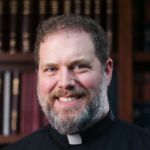
We stand at a turning point, both in the liturgical year and in the gospel narrative. We have now turned our face decidedly toward Easter, which means moving through Lent in all its fullness. In the Gospels, the Transfiguration traditionally marks the high point before Jesus “sets his face to Jerusalem” (Luke 9:51)—that is, toward the events of Holy Week.
Jesus has been slowly revealing himself to the people. Just before this, Peter in fact caught a glimpse of Jesus’ identity and declared him to be the Son of God, the Christ. Peter, then, along with James and John, is allowed to see this moment of transcendence on the mountain—a moment that, in its brightness, will make the events to come all the darker. In fact, Jesus insists that the three disciples make no mention of what they have seen until “after the Son of Man has been raised from the dead.”
In a sense, maybe, this was as much descriptive as prescriptive. In the anxiety and confusion following Jesus’ trial and execution, what would the memory of this event really signify? It may have seemed a mere dream, because if it were true, if this Jesus really were the glorious figure they saw on the mountain, how could he be dead at the hands of angry men? How could the Son of the heavenly Father find his end amid shame and agony? It was only afterward, in light of the Lord’s resurrection, that Peter was able to look back, as he does in his second epistle (1:16-18), and see the event in its own light, as a miraculous witness to Jesus’ identity that would inspire and confirm the apostolic Faith.
How exactly did the Transfiguration confirm Peter’s faith? “We did not follow cleverly devised myths,” Peter writes, “when we made known to you the power and coming of our Lord Jesus Christ.” It’s strange that he says this because, for many readers today, the Transfiguration seems rather more like a cleverly devised myth than a historical event.
What’s odd about the Transfiguration, in comparison with other miracles, is that we are never exactly sure what it is. Today we don’t often see people walking on water, or multiplying loaves and fish, or healing the blind, but at least we have an idea of what it would mean to do such things. There’s no conceptual difficulty imagining them, whether or not we believe they happened. But the Transfiguration, unlike those other events, is not merely the supernatural reversal of the typical order of things, or the unexplained happening of what is under normal circumstances impossible. It is a “special effects” moment in the purest form, in that it defies clear description. Even the name is vague: we can use the word “transfigure” to say something moved beyond its normal form or appearance, but it is hard, maybe even impossible, to give an experiential weight to what this might mean.
Maybe that’s why the experience on the mountain was so important as a turning point for Peter and the others. By it they knew that Jesus was not just the fulfillment of all their hopes, but someone who surpassed their hopes and changed them, who offered them not what they had always wanted, but what they had never imagined.
There were many miraculous signs in Jesus’ ministry, and these all showed, to one degree or another, Jesus’ power. Jesus calmed the storm, showing his power over nature; he cast out demons, showing his power over the spirits; he healed the sick, showing his power to give life. The Transfiguration was not “cleverly devised” because, unlike the other miracles, it wasn’t entirely clear what it was supposed to show.
St. Paul, in our reading from 2 Timothy, suggests obliquely what it means, for Christ “in his appearance” has “abolished death and brought life and immortality to light through the gospel” (1:10). The three disciples were “eyewitnesses to his majesty,” Peter says. But what they saw and heard was another level of witness, for they saw Moses and Elijah—signs of the Law and the Prophets—giving witness to Jesus, and they heard the voice of the Father in heaven giving testimony to his Son. “This is my Son, my beloved. . . . Listen to him.”
The Father’s instruction is, at least partly, a response to Peter’s initial reaction: “I will make three dwellings here.” It was a natural thing to say: here we have this miraculous event beyond description, and so it is only human to seek for a way to remember it, to make it permanently accessible.
But the response, which drives Peter and the others to the ground, is really remarkable: no, Peter, there is no need for three tabernacles, because the tabernacle of God is already with men. Here, Peter, is my beloved Son. Listen to him. In other words, he is not simply another mediator along the same lines as the Law and the Prophets, he is not simply another witness to a reality beyond himself. He is himself the thing that needs to be witnessed. Pay attention to him. He is already the tabernacle of God. There is no need to build another. He is already a permanent remembrance, because he will always be with you. Listen to him.
Listen to him. And what does Jesus say? “Arise, and be not afraid.”
That’s a message for us as much as it is to Peter, James and John. It’s one of the simplest instructions, but one of the hardest to do: be not afraid. For Paul in 2 Timothy, the revelation of Christ’s glory is what enables us to endure suffering and hardship.
In a way, each of the miracles of Jesus is meant to show why we should not be afraid. We shouldn’t fear the storm, because Jesus is lord of all creation. We needn’t fear sickness, because Jesus is the great physician. We needn’t fear death, because God has shown his power over it. We needn’t fear the cross, because Christ has made it the sign of his triumph. And here, at the Transfiguration, we needn’t fear the radiance of the Son’s glory. Why? Because the more we behold that glory, the more it transfigures us into its likeness. The more it blinds our earthly sight, the more it opens our spiritual sight to its wonder.
All of this is in today’s collect in Divine Worship:
O God, who before the Passion of thy Only Begotten Son didst reveal his glory upon the holy mount: grant unto us that we, beholding by faith the light of his countenance, may be strengthened to bear our cross, and be changed into his likeness from glory to glory.
God grants us to behold the light of Christ by faith, and through that vision we are changed into his likeness. But let’s not forget the middle step. The light also strengthens us to bear the cross, as it did Jesus, and as it did the apostles.And the cross is the only way forward. There’s no way around—just through. We can’t skip from here to Easter. That’s the whole purpose of the liturgical year, and the place where we now stand in it: we cannot understand glory without the Passion. We cannot forsake our fears until we rise up and follow Jesus the whole way through. Like Peter, our witness to his glory will always be shortsighted until we get the full story.
That’s one way of putting it, but it’s not quite right, because we know, in a basic way, the full story. We know where all this is headed, both in the Gospel story and in its re-presentation in the liturgical year. We know what Peter didn’t yet know—that Jesus does, in the end, rise from the dead in glorious majesty.
But the question isn’t whether we know the informational details of the narrative, but whether we are prepared to “listen to” the Son of God, whether we can actually rise up and fear not. I want to suggest that this is primarily a question not of history, or of Bible knowledge or theology, but of the living experience of faith. In that sense we’re on the mountain with Peter and the apostles.
We like to speak in shorthand of faith as a kind of knowledge in the dark, but in fact all faith requires some kind of sight, even if it is something as simple as the trustworthiness of a witness. And the sight that holy Tradition gives us—limited as it may be—consists of the necessity that we walk again, year by year, through the life of Jesus. That is what Lent—including Holy Week—is about.
God does not intend for us to blindly follow “cleverly devised myths.” He wants us to walk in the steps of his Son so that we can listen to his voice. He wants us to be eyewitnesses to his glory so that we can rise up, cast off our fear, and take up our cross.



